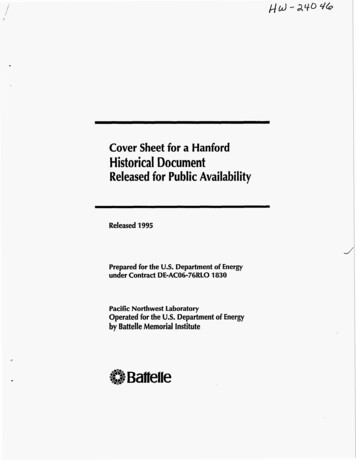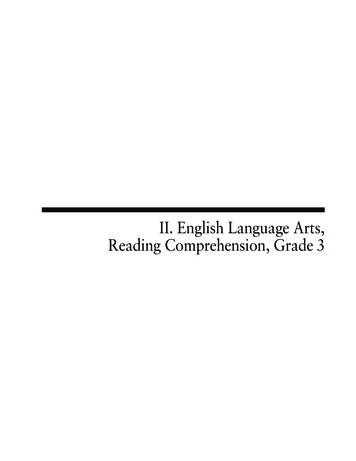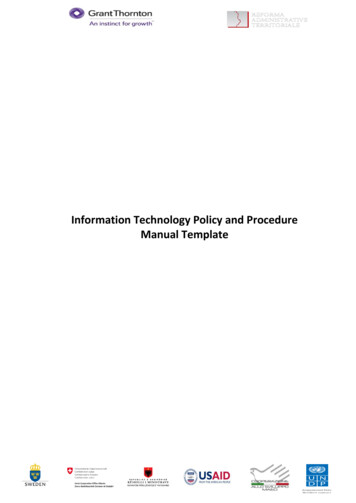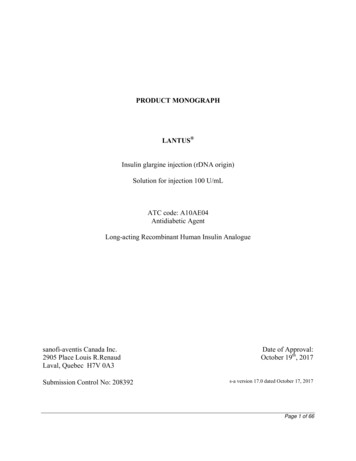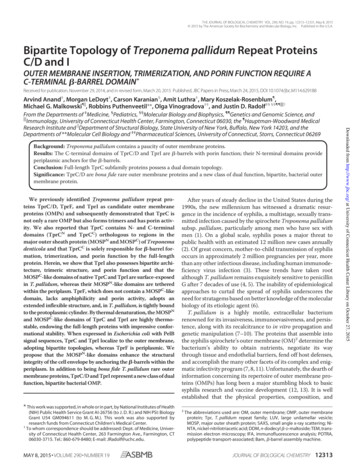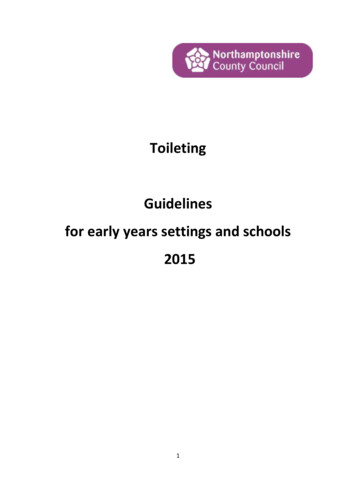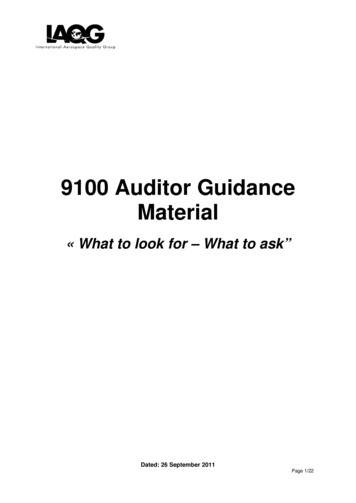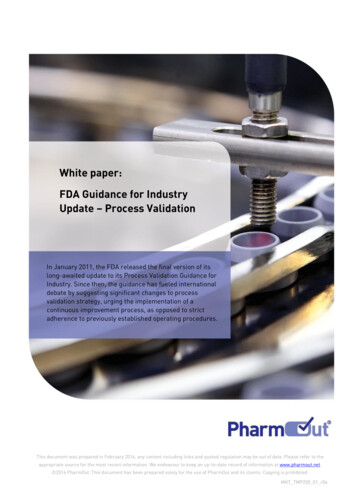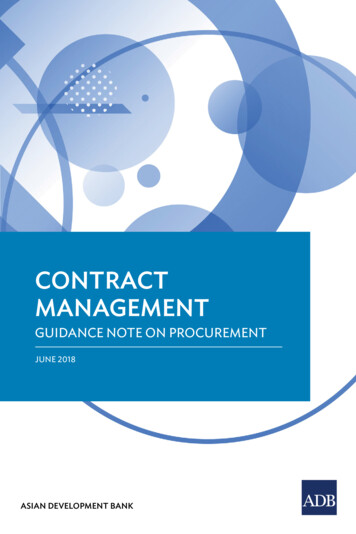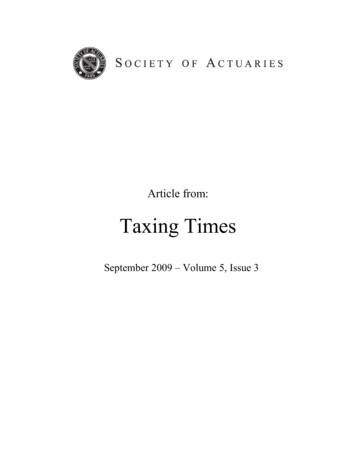
Transcription
Article from:Taxing TimesSeptember 2009 – Volume 5, Issue 3
GUIDANCERELEASED ONCOLI BESTPRACTICES RULESBy John T. Adney, Bryan W. Keene, and Joel W. MannOn May 22, 2009, the Internal Revenue Service(“IRS”) released Notice 2009-48 (the “IRSNotice”), which provides significant clarificationin question-and-answer format on several provisions of thecorporate-owned life insurance (“COLI”) “best practices”rules that were codified in section 101(j)1 by the PensionProtection Act of 2006 (the “PPA”).2 The IRS Notice becameeffective June 15, 2009, but it states that the IRS will not challenge a taxpayer who made a good faith effort to comply withsection 101(j) based on a reasonable interpretation of that section before the effective date. The IRS released the new guidance at least in part in response to a request by the AmericanCouncil of Life Insurers (“ACLI”) in 2007. In its request forguidance, the ACLI brought to the Treasury Department’s(“Treasury”) attention several areas of uncertainty regardingsection 101(j). Agreeing that these areas merited further clarification, Treasury and the IRS placed the matter on their combined 2008-2009 Priority Guidance Plan and subsequentlyreleased the IRS Notice. This article provides a brief review ofthe rules of section 101(j) and then summarizes the guidancecontained in the IRS Notice.REVIEW OF SECTION 101(J)Subject to certain transition rules, section 101(j) generallydenies the exclusion from income under section 101(a)(1)for death benefits under an “employer-owned life insurancecontract” to the extent they exceed the premiums and otheramounts paid for the contract. An employer-owned life insurance contract is a life insurance contract that 1) is owned by atrade or business, 2) directly or indirectly designates that tradeor business as the beneficiary, 3) covers the life of an insuredwho is an employee of the “applicable policyholder” whenthe contract is issued, and 4) is issued or “materially changed”after Aug. 17, 2006. An applicable policyholder is a personwho engages in a trade or business and owns an employerowned life insurance contract, or is a related person.3Several exceptions to the general exclusion disallowancerule are available. One set of exceptions is based on whetheramounts are paid to the insured’s heirs.4 The other set is basedon the insured’s status with the applicable policyholder,namely, insureds who were employees within 12 monthsof their death and insureds who were directors or “highlycompensated” at the time the contract was issued.5 None of theexceptions applies unless the employer, before the contractis issued, 1) notifies the insured in writing that the employerintends to procure the coverage, including the maximum facevalue for which the person could be insured; 2) obtains theinsured’s written consent to the coverage and to the possiblecontinuation of the coverage after the insured terminatesemployment; and 3) informs the insured in writing that theemployer will be the contract beneficiary.6GUIDANCE ON NOTICE AND CONSENTREQUIREMENTSOne of the concerns that the ACLI raised in its request forguidance was the lack of any mechanism to correct inadvertent “foot faults” made in attempting to comply with thenotice and consent requirements before a contract was issued.The IRS Notice provides, in response, that the IRS will notchallenge an inadvertent failure to satisfy those requirementsif 1) the employer made a good faith effort to satisfy them,2) the failure was inadvertent, and 3) the employer correctsthe error by the due date of its tax return for the year thecontract was issued. 7 This “self-help” correction mechanismgives employers acting in good faith considerable leewayand should alleviate concerns that innocent and inevitablehuman errors would have harsh consequences. The keyto effective utilization of this self-help mechanism isprompt discovery and correction of the error. In the absenceof prompt action, there is no means under section 101(j)of correcting an inadvertent failure to comply withthe notice and consent requirements. Hence, in the caseof a failure discovered beyond the timeframe permittedunder the IRS Notice, the only recourse would seem tobe surrender of the affected contracts or, possibly, seekinga closing agreement with the IRS coupled with belatedcompliance with the statute’s requirements.Another question that arose when taxpayers began implementing the notice and consent requirements was how longan employee’s consent remains valid. In other words, couldCONTINUED ON PAGE 38SEPTEMBER 2009 TAXING TIMES 37
GUIDANCE RELEASED ON COLI BEST PRACTICES RULES FROM PAGE 37In addition to the foregoing, the IRS Notice also clarifiesthat 1) notice and consent is required of an owner-employeeof a wholly-owned corporation; 2) notice and consent is notrequired with regard to an existing life insurance contract thatan employee irrevocably transfers to an employer, becausethe transfer itself is sufficient to satisfy the notice and consentrequirements; and 3) the notification to the employee of themaximum face amount for which the employee could beinsured must be satisfied by using either a dollar amount ora multiple of salary, and not a general statement such as “themaximum face amount for which you can be insured.”12GUIDANCE ON THE ISSUE DATEOF A CONTRACTan otherwise valid consent become “stale” if there was somedelay in issuing the contract after the consent was obtained?This could occur, for example, if outside events delayed theplan moving forward after consents were obtained, or if aplan was implemented in multiple steps. With regard to thelatter possibility, a related question became whether a singleconsent with respect to a given face amount could be usedto purchase two or more smaller contracts that totaled to theamount for which the consent was given. The IRS Noticeanswers both of these questions. It provides that consent remains valid up to one year from when it was obtained, or up tothe date the employment relationship ends—whichever occurs earlier.8 It also provides that a single consent may applyto multiple contracts covering the life of the same insured, solong as the maximum face value to which the employee consented is not surpassed.9 Taken together, these two rules suggest that if an employer plans to purchase multiple contractsbased on a single consent, it should do so within a year of theconsent or else the consent will expire. (The stale consentissue is discussed further below.)Still another question that arose soon after section 101(j)was added to the Code was whether the “written” notice andconsent requirements could be met via electronic means.The IRS Notice clarifies that they can, as long as theelectronic notification and consent system has elements inplace similar to the administrative requirements in the caseof electronically filed Forms W-4.10 It is our understandingthat some employers have already been providing noticeand obtaining consent electronically, based in part on thegeneral applicability of the federal “E-SIGN” statute. 11Those employers will likely want to review the IRS Noticeto ensure that their current electronic system complies withthe new guidance.38 TAXING TIMES SEPTEMBER 2009There also has been general concern over what date a contractwill be considered “issued” for purposes of section 101(j). Theconcern arises because the new rules apply only to contracts“issued” after Aug. 17, 2006, and because the notice and consent requirements must be met before the contract is “issued.”For example, it is common for large purchases of employerowned life insurance to be accomplished using a bindingpremium receipt, which provides immediate coverage for aspecific amount of time, such as until the underwriting process is complete. If a contract was deemed “issued” beforethis binding premium receipt became effective, notice andconsent would not be timely if accomplished after that time,which would often be the case.The IRS Notice provides a reasonable and flexible responseto this type of concern by clarifying that a contract’s “issue”date is the latest of 1) the date of application for coverage,2) the effective date of coverage, or 3) the formal issuanceof the contract.13 Thus, for example, the fact that a binder iseffective before notice and consent are obtained will not necessarily cause a violation. As discussed below, this definitionof “issue” date also has implications for the transition rulesgoverning section 101(j)’s application and for determiningthe insured’s status as a director or as “highly compensated.”GUIDANCE ON TRANSITION RULESSection 101(j) applies only to contracts issued after Aug. 17,2006, “except for a contract issued after such date pursuantto an exchange described in section 1035 for a contract issued on or prior to that date.”14 For this purpose, “any materialincrease in the death benefit or other material change shallcause the contract to be treated as a new contract.”15 While it iscommon for statutory enactments to treat a material change toa life insurance contract as giving rise to a new contract,16 the
exception for contracts exchanged pursuant to section 1035was somewhat novel. This novelty has created confusion overthe interaction between the two provisions.The confusion stems from the appearance that the two rules,taken together, suggest that a deemed exchange resulting froma material change will trigger the rule’s effective date, whereas an actual exchange of contracts will not—i.e., the section1035 exchange rule could be read to “swallow” the materialchange rule. The IRS Notice interprets these rules by retainingsome meaning for each, stating that an actual exchange “thatresults in a material increase in death benefit or other materialchange (other than a change in issuer) is treated as the issuance of a new contract.”17 In effect, this interpretation adds achange in the identity of the contract’s issuer to the list of itemsthat will not be considered a “material change” for purposesof the transition rules.In that regard, the IRS Notice also lists specific changes thatare not treated as material for purposes of the transition rules.These largely track a similar list that was set forth in the onlylegislative history for section 101(j).18 They are: 1) increasesin death benefit due to the operation of section 7702 or theterms of the contract (provided the insurer’s consent is notrequired); 2) administrative changes; 3) changes from generalto separate account or from separate to general account (thelatter being somewhat of an expansion, given that the legislative history referred only to changes from general account toseparate account); and 4) changes as a result of an option ora right under the contract as originally issued.19 With respectto contracts already subject to section 101(j), the IRS Noticealso provides that a material change to the contract—whetherthrough a modification to the contract or an actual exchange—will require a new notice and consent unless one remains ineffect under the “expiration” provisions summarized above(e.g., the change occurs within a year of the original noticeand consent).20Although this guidance on the perennially thorny issue ofmaterial changes is quite helpful, some questions are boundto remain. By way of example, as noted above the IRS Noticeprovides that a section 1035 exchange which also results in amaterial change, other than a change in the issuer of the contract, gives rise to a new contract for section 101(j) purposes.State law generally requires contracts issued after 2008,including those issued in an exchange, to base their mortalitycharge guarantees on the 2001 CSO mortality tables ratherthan the 1980 CSO tables. Normally, a change to a life insur-ance contract’s guaranteed mortality charges is treated as amaterial change for tax purposes.21 While the IRS Notice doesnot speak directly to this point, it may not be correct to read itas voiding the section 101(j) grandfather in this instance, forto do so could seem to swallow the section 1035 exchangerelief Congress provided in the transition rule.OTHER GUIDANCEIn its 2007 request for guidance, the ACLI noted that significant uncertainty existed with respect to the application ofsection 101(j) to various traditional insurance arrangements.The IRS Notice responds by clarifying whether 101(j) appliesin several circumstances. First, it states that a contract is anemployer-owned life insurance contract only if it is ownedby a person who engages in a trade or business, and not whenit is owned by a person who does not engage in one.22 TheIRS Notice gives the example of a life insurance contractowned by a qualified plan or VEBA that is sponsored by abusiness, and notes that such an arrangement is not subject tosection 101(j).23 Second, the IRS Notice states that a contractinvolved in a split-dollar arrangement can constitute an employer-owned life insurance contract, but any death benefitsreceived under the contract that are paid to a family memberor designated beneficiary of the insured are excluded from income dueAlthough thisto section 101(j)(2)(B).24 Finally,the IRS Notice provides that a lifeguidance on theinsurance contract owned by a partperennially thornynership or sole proprietorship maystill constitute an employer-ownedissue of materiallife insurance contract, but not if thecontract is owned by a sole proprichanges is quiteetor and covers his or her own life.25helpful, someIn addition to the foregoing, thequestions areIRS Notice provides several otherclarifications. First, it specifies thatbound to remain.for purposes of section 101(j), theterm “employee” is not limited to common law employees.Second, the IRS Notice provides that in order to qualify forthe exception in section 101(j)(2)(B)(ii) that allows deathbenefits to remain tax free when they are used to purchase anequity (or capital or profits) interest in the employer (technically, the applicable policyholder) from family members ordesignated beneficiaries of the insured, the death benefitsmust be so used by the due date, including extensions, of thetax return for the taxable year in which the employer is treatedas receiving them under the contract.26CONTINUED ON PAGE 40SEPTEMBER 2009 TAXING TIMES 39
GUIDANCE RELEASED ON COLI BEST PRACTICES RULES FROM PAGE 39John T. Adneyis a partner withthe Washington,D.C. law firm ofDavis & HarmanLLP and maybe reached atjtadney@davisharman.com.Bryan W. Keeneis a partner in theWashington, D.C.law firm of Davis& Harman LLP andmay be reached atbwkeene@davisharman.com.The final item on which the IRS Notice provides guidanceis the information reporting requirements of section 6039I,which was also added to the Code by the PPA, and Form8925, which is the IRS form used to implement the reportingrequirements. Section 6039I and Form 8925 require each applicable policyholder owning one or more employer-ownedlife insurance contracts issued after Aug. 17, 2006, to providecertain information to the IRS. The ACLI had inquired in itsrequest for guidance whether multiple taxpayers could berequired to file Form 8925 by reason of the same employerowned life insurance contract, since an “applicable policyholder” could possibly include both owners of the contractsand other related parties. The IRS Notice responds by sayingthat only the applicable policyholder that owns one or moreCONCLUSIONThe IRS Notice responds to the concerns of the ACLI andothers in the industry quite thoroughly, and should be commended. The correction mechanism for inadvertent failuresto satisfy the notice and consent requirements is particularlyfavorable to taxpayers. Despite the thoroughness of the IRSNotice, however, no doubt other questions will arise in thefuture. In light of the comprehensive guidance provided underthe Notice, such remaining questions likely can be answeredadequately through the private letter ruling process. 3END NOTES1234Joel W. Mannis an associatewith theWashington, D.C.law firm of Davis& Harman LLP andmay be reachedat jwmann@davis-harman.com.employer-owned life insurance contracts is required to file theinformation return.2756789101112131415161718192021222324252627 references to “section” are to sections of the Internal Revenue Code of 1986, as amended (the “Code”).All Pub. L. No. 109-280, 120 Stat. 780 (2006). See sections 267(b) and 707(b)(1). See section 101(j)(2)(B). This includes an amount paid to purchase an equity (or capital or profits) interest in the applicable policyholder from the insured’s familymembers or certain others. See section 101(j)(2)(A). See section 101(j)(4). See Q&A-13 of Notice 2009-48. See Q&A-9 of Notice 2009-48.See Q&A-10 of Notice 2009-48. See Q&A-11 of Notice 2009-48; Treas. Reg. § 31.3402(f)(5)-1(c)(2). E-SIGN stands for the Electronic Signatures in Global and National Commerce Act, Pub. L. No. 106-229 (2004), which generally facilitates the use of electronic signatures in various instances where federal law requires a signature or communication to be “in writing.” See Q&A-7, -8, and -12 of Notice 2009-48, respectively. See Q&A-4 of Notice 2009-48. Pub. L. No. 109-280 § 863(d). Id. See S. Prt. No. 98-169, at 579 (1984) (discussing the treatment of exchanged contracts as new contracts for purposes of the effective date of section 7702). See Q&A-15 of Notice 2009-48 (emphasis added). See Staff of J. Comm. on Tax’n, 109th Cong., Technical Explanation of H.R. 4, the “Pension Protection Act of 2006,” as Passed by the House on July 28, 2006, and asConsidered by the Senate on August 3, 2006, at 212–13 (J. Comm. Print 2006). See Q&A-14 of Notice 2009-48. See Q&A-16 of Notice 2009-48. See, e.g., S. Prt. No. 98-169, at 579 (1984); H.R. Conf. Rep. No. 98-861, at 1076 (1984) (stating that the conference report follows the Senate report); Staff of J. Comm.on Tax’n, 98th Cong., General Explanation of the Revenue Provisions of the Deficit Reduction Act of 1984, at 656 (J. Comm. Print 1984). See Q&A-1 of Notice 2009-48. However, a contract owned by a grantor trust, the assets of which are treated as assets of a grantor that is engaged in a trade or business, constitutes an employerowned life insurance contract and is subject to section 101(j). See Q&A-2 of Notice 2009-48. The statement in the IRS Notice is true, of course, only if the statute’s notice and consent requirements are met. See Q&A-3 of Notice 2009-48.See Q&A-5 and -6 of Notice 2009-48, respectively. See Q&A-17 of Notice 2009-48.40 TAXING TIMES SEPTEMBER 2009
corporate-owned life insurance (“COLI”) “best practices” rules that were codified in section 101(j)1 by the Pension Protection Act of 2006 (the “PPA”).2 The IRS Notice became effective June 15, 2009, but it states
